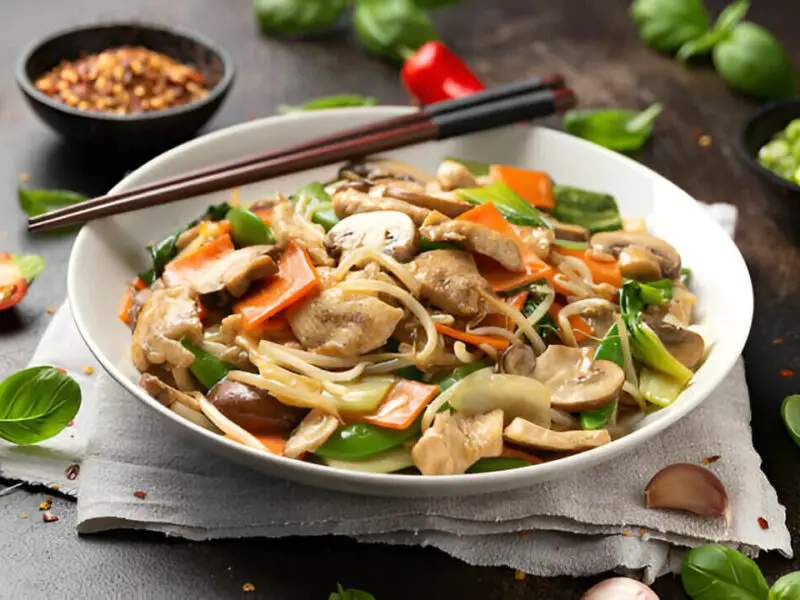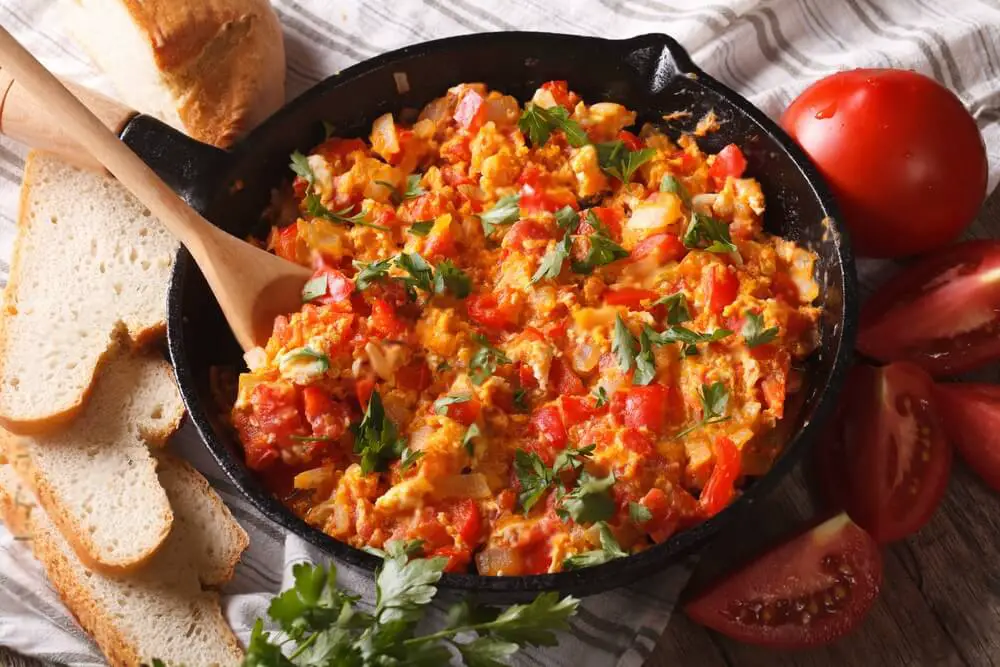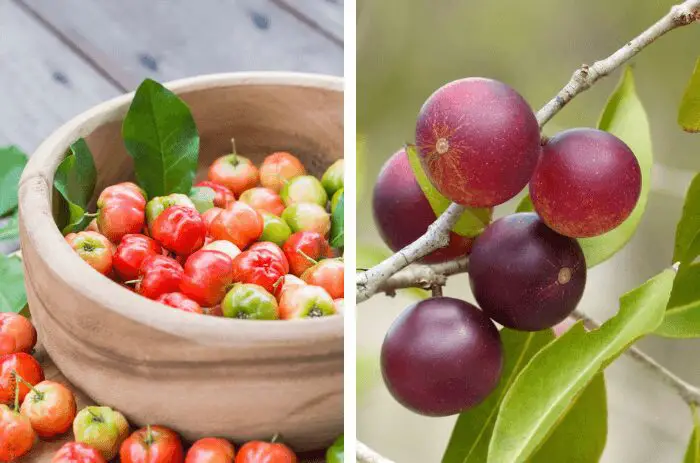If you’re a fan of Chinese takeout like me, then you’ve no doubt encountered those two dishes – moo goo gai pan and chop suey—more times than you can count on the menu. But have you ever stopped to think about what exactly makes them different? Beyond just “one has chicken, the other has mixed stuff,” I mean.
I know I always just ordered whichever one sounded good that day without really thinking about it. But one day I started wondering—are they really that similar? What even are the origins of these dishes anyway? I decided I needed to get to the bottom of this Moo Goo Gai Pan vs. Chop Suey mystery once and for all.
So I did some digging around and let me tell you, I found way more than I bargained for. It turns out there’s a whole story behind how these dishes developed in America and how they’ve evolved over time. And the differences between them go way deeper than just the ingredients.
What Is Moo Goo Gai?
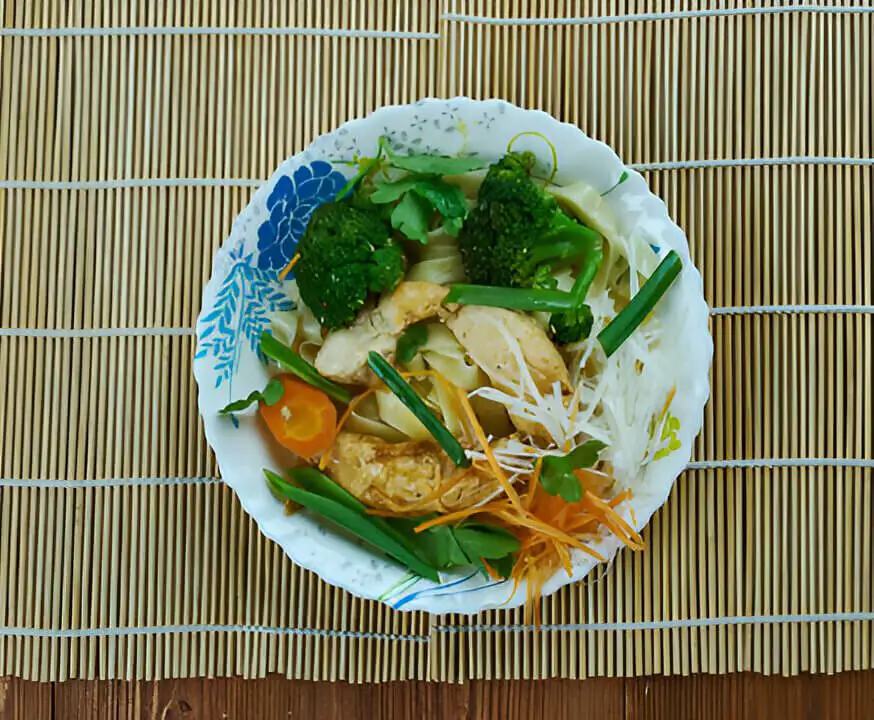
Now, you might be thinking this is just some traditional Chinese dish that’s been around for centuries. But you’d be wrong—moo goo gai pan is actually an American invention through and through.
It all began back In the early 1900s, the first big wave of Chinese immigrants came to the US looking for opportunities. A lot of these newcomers ended up working in Chinese restaurants catering to other immigrants here. But they soon realized they needed to start appealing to mainstream American tastes if they wanted to make any real money.
That’s where the concept of “Chinese American” food was born. Chefs started taking authentic Chinese recipes and tweaking them to be more familiar and palatable to people without experience with Chinese flavors and cooking styles. One dish they experimented with was called “mu gu gai pin” in Chinese, which literally means “chicken with wood ear mushrooms”. It was a classic stir fry back in China.
But when American Chinese restaurant chefs tried making it, they ran into a problem – wood ear mushrooms just weren’t available or affordable here like they were back in Asia. So they subbed in the much more common button mushrooms instead. And because Americans were used to bigger pieces of protein, they cut the chicken into bite-sized strips rather than the small dice used in China.
They also added some new veggies into the mix like carrots and bamboo shoots to make it brighter and more visually appealing. But the biggest change was to the sauce. In China, mu gu gai pin was served with a bold, fermented black bean sauce. But American taste buds weren’t ready for that intense flavor yet. So the chefs created a lighter, broth-based sauce to bring the ingredients together in a more subtle, less challenging way.
And just like that, a whole new dish was born – moo goo gai pan. The name is believed to be a playful mispronunciation of “mu gu gai pin” meant to make it easier for English speakers to say. Word quickly spread about this tasty new stir fry creation and it became a fast favorite on Chinese restaurant menus across America. Over time it evolved even further by adding veggies like water chestnuts and snow peas.
What Is Chop Suey?
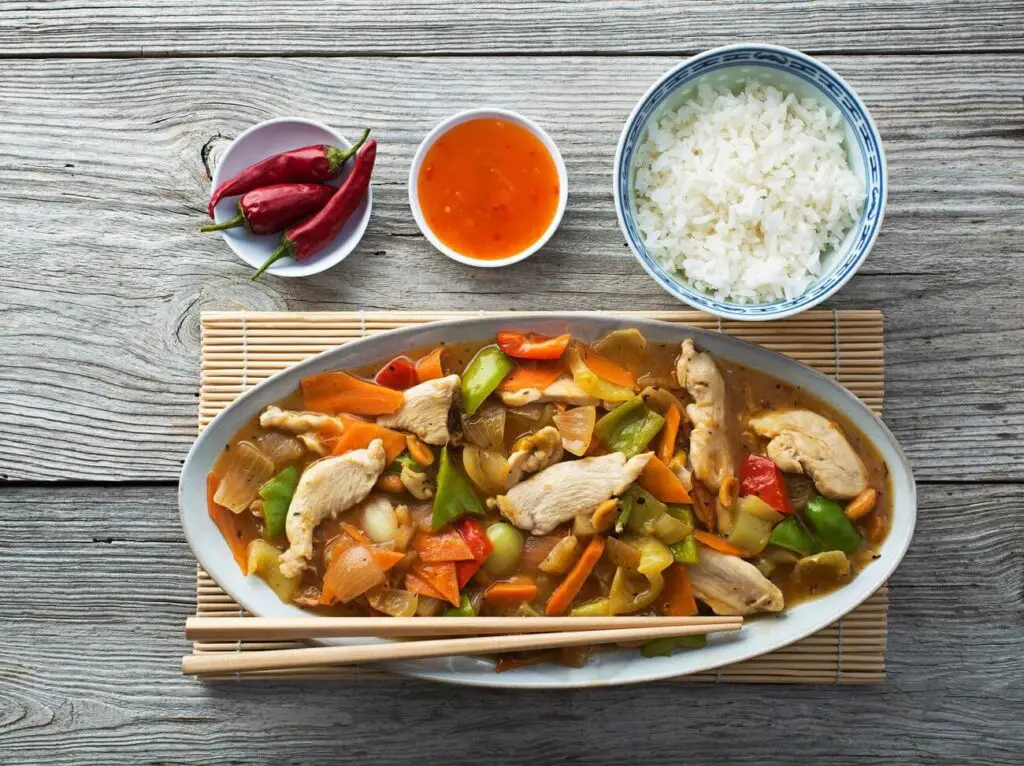
This one’s origin story is just as interesting as moo goo gai pan’s, so get comfortable because we’re diving deep!
From what food historians have been able to piece together, chop suey likely first popped up in San Francisco sometime in the 1880s. This was during the Gold Rush era when tons of Chinese laborers were immigrating to California to work grueling jobs building the first Transcontinental Railroad. Naturally, they needed places to get affordable, filling meals – enter the early Chinese restaurants.
But these restaurants faced a lot of prejudice and “No Dogs or Chinese” signs were common. So like with moo goo gai pan later on, the chefs knew they had to find a way to attract non-Chinese customers if they wanted to stay in business. That’s when the idea of chop suey was born.
The name Is believed to be a phonetic translation of the Chinese phrase “tsap sui”, meaning “miscellaneous bits and pieces”. Because money was tight, these early chop suey dishes would contain whatever assorted leftovers and scraps the kitchen had on hand – a bit of pork, some cabbage, random veggies, etc. It was essentially Chinese cuisine’s version of scrap-frying.
But Americans took a liking to the mishmash of flavors and textures. Word spread and soon chop suey became one of the first widely popular Chinese dishes stateside. Over the decades, it evolved into the dish we know today with standardized mixes of protein, cabbage, and bean sprouts in a sweetened soy sauce.
Interestingly, chop suey was also one of the first Chinese dishes to adopt a more “Americanized” cooking style of stir frying over steaming or braising. This made it quicker to prepare in bulk and more visually exciting compared to milder Chinese home cooking at the time. So in many ways, chop suey helped shape Americans’ perceptions of what Chinese food even was. What started as a scrappy way to use leftovers ended up taking the country by storm!
Moo Goo Gai Pan Vs. Chop Suey: What’s The Difference?
Ingredients
When it comes to moo goo gai pan, you can pretty much guarantee three main ingredients – chicken, mushrooms, and vegetables. The chicken is almost always sliced into bite-sized pieces so it’s easy to pick up with chopsticks or a fork. Button mushrooms are the mushroom of choice for providing a subtle earthiness to balance the other flavors.
As for veggies, you’ll commonly find basics like carrots, celery, and bamboo shoots which add crunch and visual appeal. Sometimes places will get creative and throw in extras like water chestnuts, snow peas, or broccoli too. But the core trio of protein, fungus, and vegetables remains consistent. Everything is stir-fried together in a simple sauce.
Chop suey, on the other hand, tends to have more variability in its ingredients. While a typical batch might use chicken and cabbage like the old-school recipes, some restaurants have really expanded the mix over the decades. Now you’ll find chop suey made with beef, shrimp, or tofu depending on personal taste.
The veggie lineup is even more eclectic, with classics like bean sprouts sitting alongside bell peppers, bok choy, or whatever seasonal produce looks good. You may even spot the odd Ingredient like pineapple or cashews making a cameo. With chop suey, the motto is basically “more Is more”.
Flavor
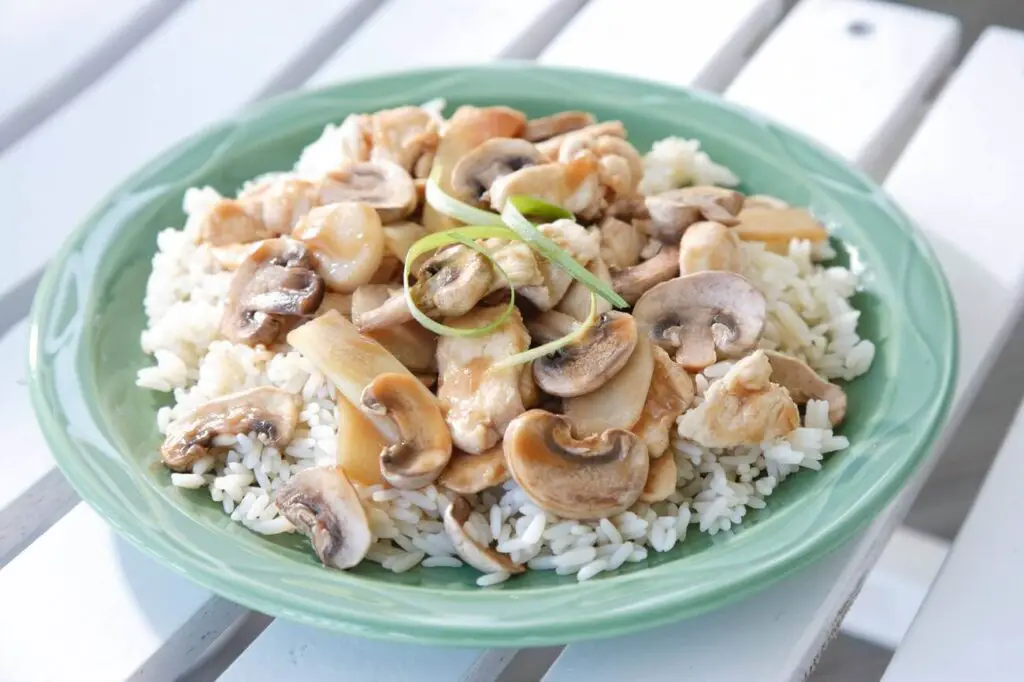
If ingredients are the foundation, then flavors are really what define these dishes. So how do moo goo gai pan and chop suey compare on the taste front?
Generally speaking, moo goo gai pan has a lighter, more subtle flavor profile. The chicken and mushrooms don’t add much inherent savoriness, so the sauce plays a key supporting role. It’s typically based around a savory chicken or vegetable stock that’s been thickened with cornstarch for body.
This results in a brothy, umami-rich sauce that gently coats the other ingredients rather than powering through with a lot of intense seasonings. The flavors are very mellow and work together harmoniously without any one element dominating. It’s easy to enjoy large portions without feeling overwhelmed.
Chop suey, on the flip side, tends to have bolder, richer flavors. A big part of that comes from its signature sweet-savory sauce. Soy sauce is the dominant seasoning and provides a deep, full-bodied savoriness. It’s often combined with oyster sauce, which amplifies the umami but also adds hints of brininess.
To balance that out, chop suey sauce frequently contains a touch of brown sugar or honey. This creates a more complex interplay of flavors as the sweetness cuts through the saltiness. Some chefs even throw in a dash of rice vinegar or Chinese wine for extra dimensions of tang and aroma.
Sauces
As we’ve discussed, the sauce plays a big role in tying everything together and elevating the flavors in both moo goo gai pan and chop suey. So how do their sauces differ?
For moo goo gai pan, the sauce is quite simple – it’s primarily based on chicken or vegetable stock that’s been thickened with a little cornstarch slurry. The stock provides a light, clean backdrop of umami to enhance the other ingredients without overwhelming them. You’ll sometimes find dashes of soy sauce, oyster sauce or rice wine added for extra depth but it’s kept quite subtle.
The goal is a brothy, clingy sauce that gently coats everything without a strong presence of its own. It allows the flavors of the chicken and mushrooms to shine through while adding just enough richness. The result is a very mellow, harmonious sauce perfect for mild palates.
Chop suey sauce, on the other hand, is where the real flavor magic happens. Soy sauce takes center stage, contributing bold saltiness. Oyster sauce then amplifies the umami and brings hints of brininess. Brown sugar or honey adds sweet complexity to offset the salty-savory notes.
Sometimes rice wine, Chinese cooking wine or rice vinegar are mixed in as well to boost the aromatic flavors. All these layers create a much more complex, assertive sauce with an almost gravy-like texture. It powerfully carries the flavor party rather than fading into the background like moo goo gai pan’s sauce.
Cultural Significance
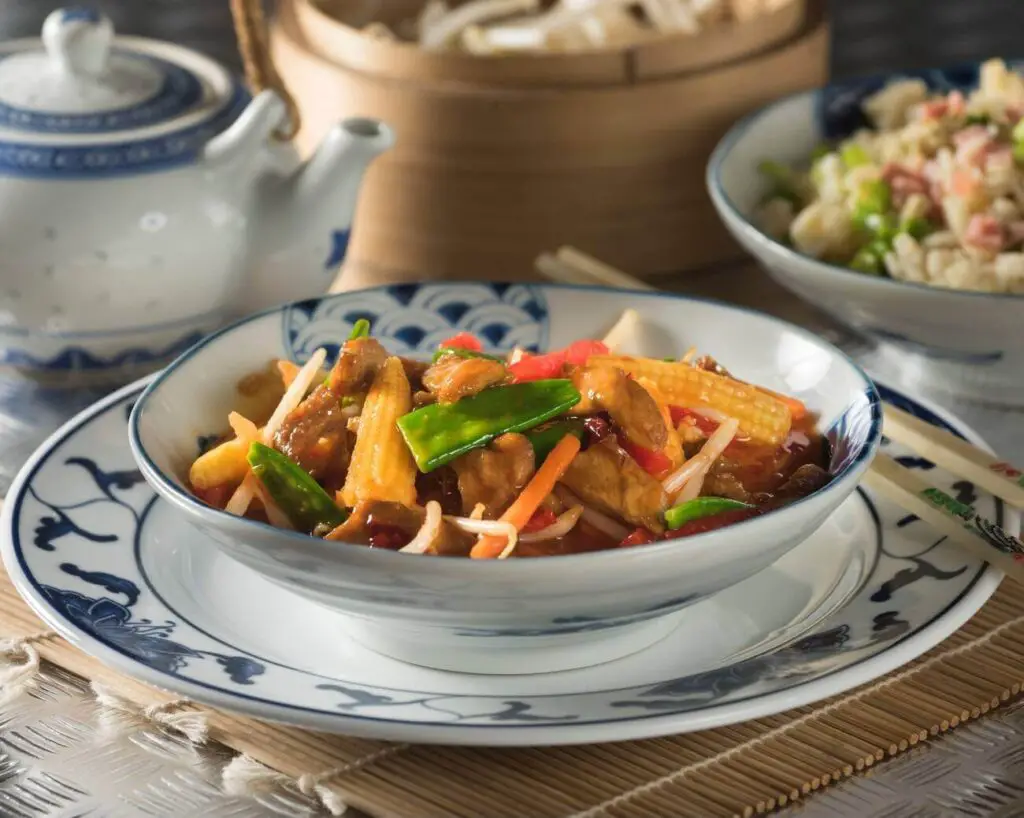
These dishes tell an interesting story about the immigrant experience and changing American palates.
We’ve learned that both originated as creative adaptations by early Chinese immigrant chefs trying to appeal to non-Chinese customers. They took traditional Chinese recipes and “translated” them into more familiar forms using ingredients and flavors Westerners would enjoy. In doing so, they helped shape mainstream perceptions of Chinese food in America.
Moo goo gai pan and chop suey were two of the first Chinese dishes to really catch on with the general public in a big way. Their popularity spread as more Chinese restaurants popped up across the country in the early 1900s. Gradually, they became ingrained in American culture as quintessential “Chinese food.” It’s easy to forget now that they weren’t always seen that way.
Over the following decades as tastes evolved, the dishes continued adapting too. Chop suey incorporated new proteins and veggies while moo goo gai pan’s vegetable lineup expanded. Sauces in both got richer and heavier on the umami bomb. By the mid-1900s, they’d fully solidified their place on Chinese takeout menus everywhere.
Even today as “authentic” regional cuisines gain more recognition, moo goo gai pan and chop suey still retain their nostalgic appeal. Their familiar flavors and comfort-food qualities keep customers loyal generation after generation. Whether ordering for a family weeknight meal or college dorm feast, their reliability is part of the draw.
In a way, these dishes have come full circle by fusing Chinese techniques with American preferences. Though very different from their Chinese inspirations now, they represent the melting pot nature of our country’s cuisine. Their history shows how immigrant foodways can evolve into new cultural creations beloved by all. Not bad for a pair of dishes that were once just improvised experiments!
FAQs
Can I make moo goo gai pan or chop suey at home?
Absolutely! Both dishes are very approachable to make yourself. The ingredients are readily available at most grocery stores. Just be sure to have chicken stock, soy sauce, oyster sauce, brown sugar, and cornstarch on hand. A wok is ideal but not necessary – a large skillet works great too. Follow the basic recipes and techniques we discussed earlier. You’ll be enjoying restaurant-quality dishes in no time!
What are some variations on moo goo gai pan and chop suey?
Chefs often get creative with these classics by swapping out different proteins and veggies. Popular variants include beef & broccoli moo goo gai pan, shrimp chop suey, and tofu & vegetable chop suey for vegetarians. You’ll also find riffs like “chopped chicken” using diced chicken or “moo shu pork” wraps inspired by the flavors. And some places stir fry the ingredients separately for distinct textures. Feel free to experiment with your favorite combinations.
Can these dishes be made ahead of time or reheated well?
Yes, both moo goo gai pan and chop suey hold up great when made in advance or reheated later. The sauces help keep everything moist. I like to make a big batch on Sunday for easy weekday meals. Just store in an airtight container in the fridge for up to 4 days. To reheat, either stir fry briefly or microwave in 30-second intervals until piping hot. The flavors deepen the next day too.
Do these dishes have any health halos being chicken and vegetable based?
While not necessarily “health foods,” moo goo gai pan and chop suey can definitely fit into a balanced diet. When made with minimal or no added sauces, they provide lean protein and filling fiber from the veggies. Opt for chicken or tofu over red meats. Using small amounts of soy sauce and sugar keeps sodium and calories in check too. Like most stir fries, they’re a quicker, lighter alternative to fried dishes when portion size is monitored. Everything in moderation!
Conclusion
Well there you have it folks – the definitive story of Moo Goo Gai Pan Vs. Chop Suey! I hope you learned as much as I did from diving into the history and comparing all the little differences that make these dishes distinct. It’s always fascinating to me how creative chefs can be when they put their own cultural spin on recipes.
So next time you’re craving that nostalgic Chinese restaurant flavor, hopefully you’ll be able to order with confidence knowing all the secrets behind these dishes. But don’t just take my word for it – try recreating them at home yourself using the techniques shared here. I guarantee it’ll become your new favorite weeknight meal or cozy comfort food. Until then, keep on enjoying moo goo gai pan and chop suey in all their comforting, cross-cultural glory!
